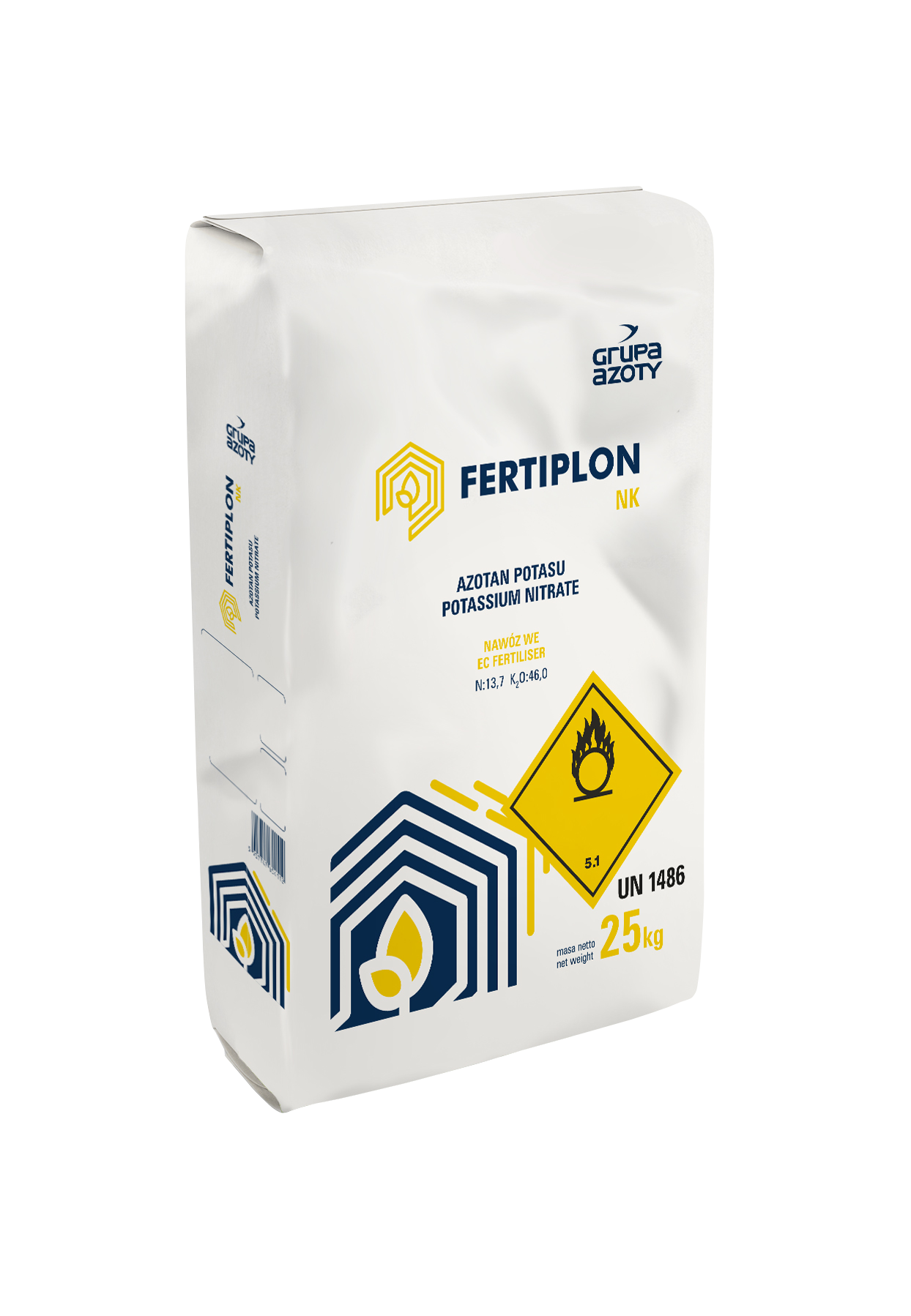
FERTIPLON NK Potassium nitrate is a specialist multicomponent nitrogen-potassium fertilizer. It is used as a fertilizer for crops under shelter and for more valuable plants in the ground and a raw material for the production of compound fertilizers. Potassium nitrate is an ideal source of nitrogen and potassium for optimal nutrtion of plants. on request.
The product can be produced with or without PETRO AG's anti-caking agent between 0.06% and 0.14%. The product delivered without ant-caking agent may become caking.
| Nutrients | % (m/m) |
| KNO3 content | At least 99 |
| Potassium soluble in water (K2O) | At least 46 |
| Nitrogen in form of nitrate (N) | At least 13.7 |
| Moisture, loss on drying at 105°C | No more than 0.30 |
| Chlorides (Cl-) | No more than 0.07 |
| Calcium and magnesium (Ca2+) | No more than 0.05 |
| Iron (Fe+3) | No more than 0.001 |
| Heavy metals (Pb+2) | No more than 0.002 |
Packaging


Storage



| Crop | Application time | Application rate (kg/ha) | Recommended number of applications | Recommended quantity of spray liquid (L/ha) |
| Solanaceous vegetables: tomato, pepper | 1st to 3rd fruit has reached typical size and form (BBCH 71 – 73) | 0.6 – 2.5 | 1 | 300 – 500 |
| 4th to 6th fruit has reached typical size and form (BBCH 74 – 76) | 0.6 – 2.5 | 1 | 300 – 500 | |
| Cucurbits: pumpkin, cucumber, zucchini | 1st – 2nd flower initial with elongated ovary visible on main stem (BBCH 51 – 52) | 0.6 – 2.5 | 1 | 300 – 500 |
| 1st – 2nd fruit on main stem has reached typical size and form (BBCH 71 – 72) | 0.6 – 2.5 | 1 | 300 – 500 | |
| Bulb vegetables: onion, garlic | Development of harvestable vegetative plant parts (BBCH 41 – 43) | 0.6 – 2.5 | 2 times at weekly interval | 300 – 500 |
| Bulb reaches 40 - 50% of typical diameter (BBCH 44 – 45) | 0.6 – 2.5 | 1 | 300 – 500 | |
| Beginning of generative shoot formation (BBCH 47) | 0.6 – 2.5 | 1 | 300 – 500 | |
| Root vegetables: carrot, parsley, celery, beetroot | Approx. 20% – 40% of roots of typical diameter (BBCH 42 – 44) | 0.6 – 2.5 | 1 | 300 – 500 |
| Approx. 50% – 70% of roots of typical diameter (BBCH 45 – 47) | 0.6 – 2.5 | 1 | 300 – 500 | |
| Approx. 80% of roots of typical diameter (BBCH 48) | 0.6 – 2.5 | 1 | 300 – 500 | |
| Leafy vegetables: head cabbage, savoy cabbage, cauliflower, broccoli | 9 leaves unfolded – beginning of head formation (BBCH 19 – 41) | 0.6 – 2.5 | 1 | 300 – 500 |
| Head reaches 20 - 30% of typical size (BBCH 42 – 43) | 0.6 – 2.5 | 1 | 300 – 500 | |
| Head reaches 40 - 50% of typical size (BBCH 44 – 45) | 0.6 – 2.5 | 1 | 300 – 500 | |
| Legumes: peas, beans | 10 - 30% of pods have reached typical length (BBCH 71 – 73) | 0.6 – 2.5 | 2 times at 2-week interval | 300 – 500 |
| Pome-fruit trees: apple tree, pear tree | Fruit reaches 60 – 80% of typical size (BBCH 76 – 78) | 1 – 4 | 1 | 500 – 800 |
| Beginning of ripening – advanced ripening (BBCH 81 – 85) | 1 – 4 | 1 | 500 – 800 | |
| Stone-fruit trees: sour cherry, cherry, plum, peach, apricot | White/pink buds (BBCH 57 – 59) | 1 – 4 | 1 | 500 – 800 |
| Dropping of non-pollinated buds – Fruit reaches 60% of typical size (BBCH 73 – 76) | 1 – 4 | 2 | 500 – 800 | |
| Fruit reaches 70 – 80% of typical size (BBCH 77 – 78) | 1 – 4 | 1 | 500 – 800 | |
| Beginning of ripening (BBCH 81) | 1 – 4 | 1 | 500 – 800 | |
| Ornamental plants | From spring to autumn | 0.1 – 0.2% solution | 3 – 4 | 100 |
Hazard Statement: H272
Precautionary Statements:
P210: Keep away from heat, hot surfaces, sparks, open flames and other ignition sources. No smoking.
P220: Keep away from clothing and other combustible materials.
P280: Wear protective gloves and eye protection.
P370+P378: In case of fire: Use water to extinguish.
P501: Dispose of contents and container to entity authorized to waste reception.
